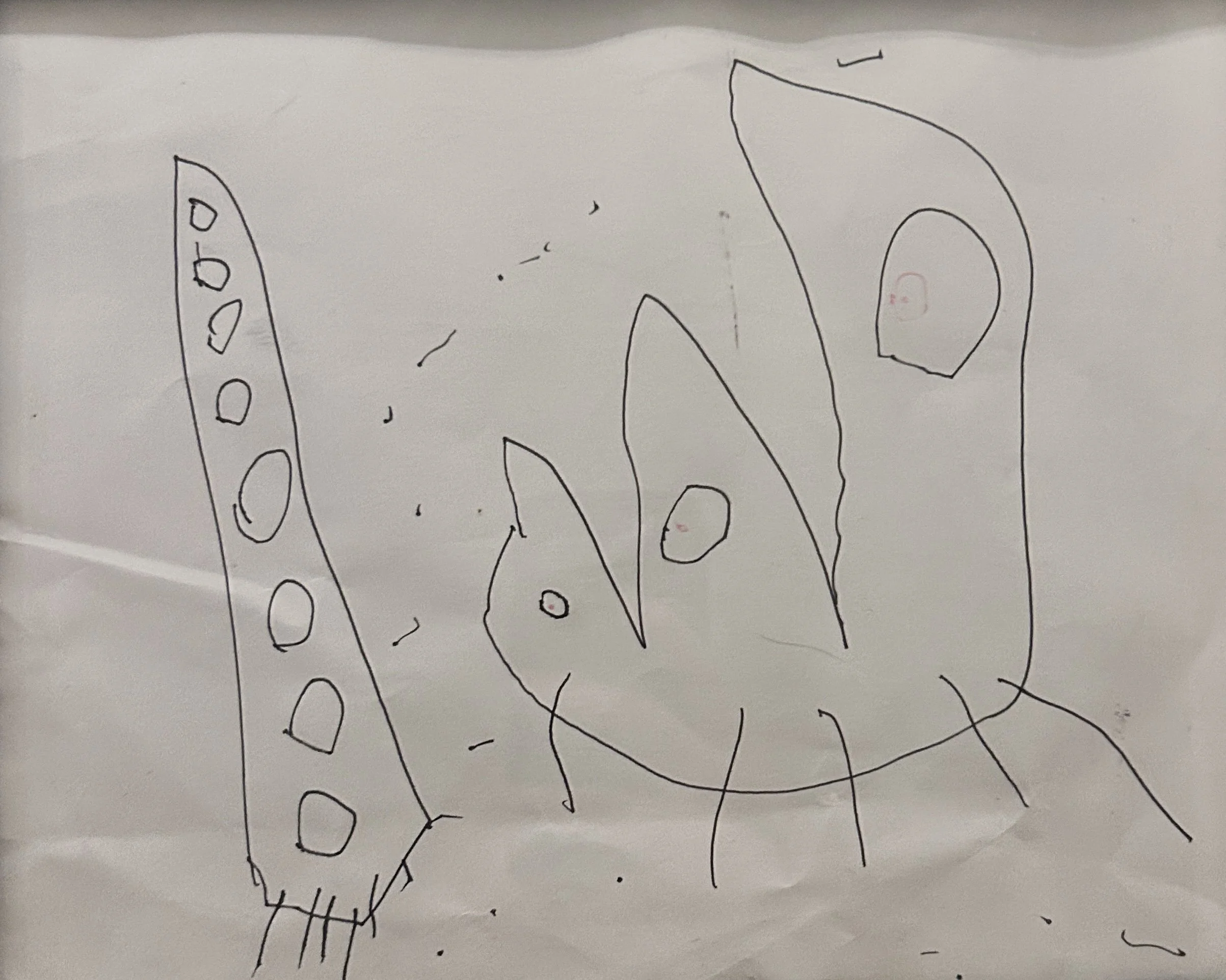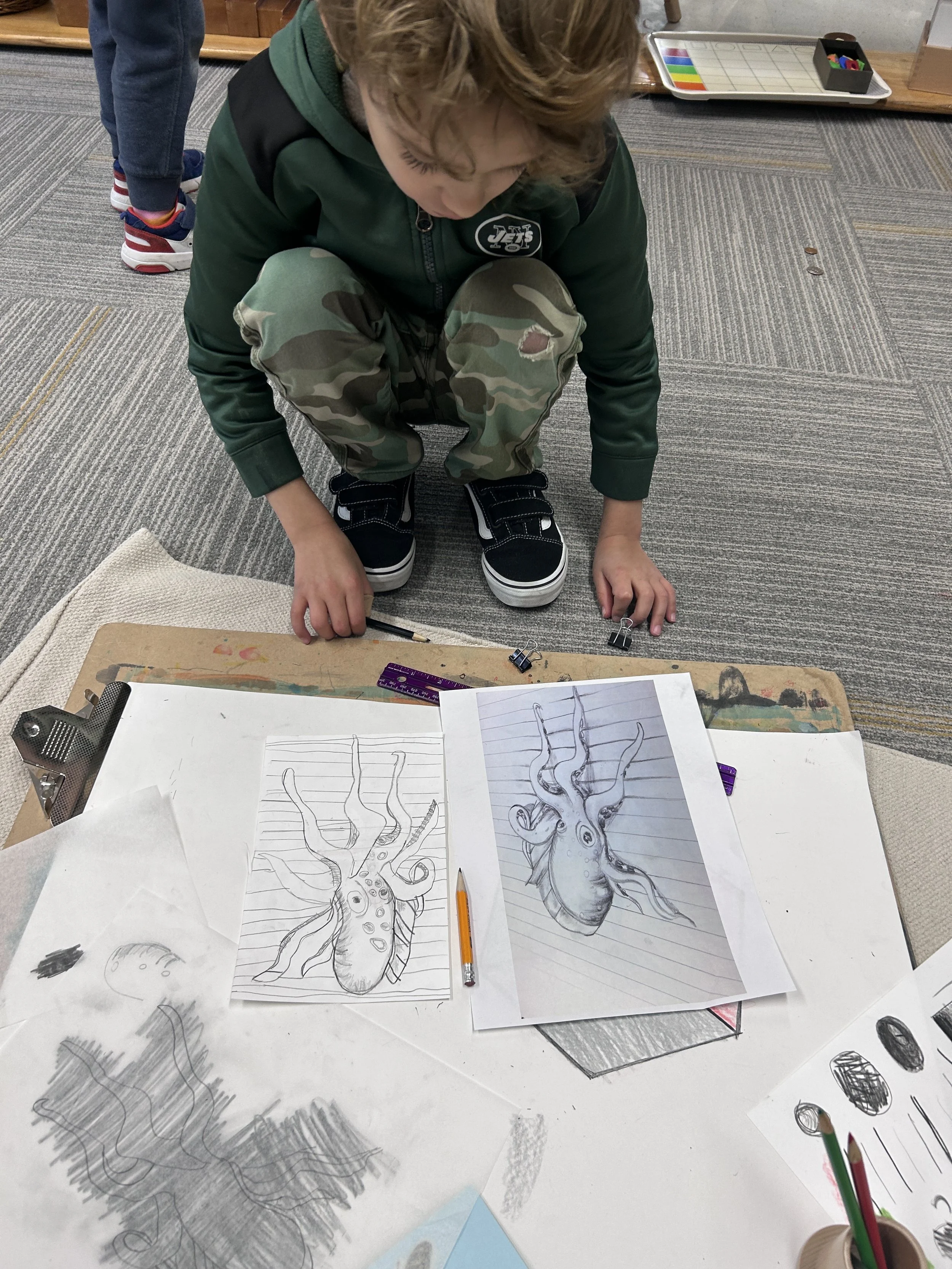Music & Art in Montessori Classrooms
This drawing was created by my three-year-old nephew, who, in a true testament to valuing process over product, immediately crumpled it up and tossed it in the trash the moment he finished. I saved it to remember that beautiful moment.
“We often forget that the imagination is a force for the discovery of truth.”
Purposeful Integration of Music and Art
In a Montessori classroom, music and art can be purposefully woven into the fabric of the prepared environment, emphasizing exploration, sensory refinement, and expressive creativity. Through gentle modeling and thoughtful invitations, children can authentically engage with these creative forms of communication at their individual developmental pace.
Art Lessons and Materials
Art lessons begin with simple demonstrations that model handling materials, such as holding a paintbrush or using paint. Through repeated exploration, children naturally refine their hand control, enhance coordination, and creatively express their inner worlds. Young children value the process of creation over the final product, and are sometimes unattached to the outcome! Adults can follow the child’s lead by recognizing the importance of the learning experience as the outcome in and of itself. Materials such as paper, crayons, colored pencils, paint, watercolor, and playdough can be intentionally accessible to children as young as 15 months, encouraging independent, spontaneous interaction. Adults can help foster intrinsic motivation, reflection, and authentic self-expression by offering neutral, observational comments, such as, “I notice you painted a yellow dot here,” or “Would you like to name your work?”
Music: Singing, Movement, and Instruments
Music is organically introduced through daily singing, movement, and access to real musical instruments. Adults can integrate singing and rhythmic movement throughout daily routines/transitions and model respectful handling/correct use of instruments. Recognizing children’s innate attraction to rhythm and melody, Montessori classrooms can provide a diverse array of musical experiences, offering, for example, child-sized percussion instruments for children to freely explore sounds and rhythms. In order to foster early music literacy, adults can thoughtfully integrate musical vocabulary by naming instruments, their parts, composers, and song titles.
Nature-Based Enrichment
Nature-based learning significantly enriches the impact of music and art in the Montessori environment. Allowing children to observe and engage with natural materials, plants, and insects outdoors enhances their visual discrimination skills, such as noticing details, identifying colors and patterns, and fostering an appreciation for natural beauty. Similarly, adults can highlight natural sounds such as birdsong, rustling leaves, or flowing water, to help bring awareness to the quality and texture of various sounds. These interactions deepen auditory awareness, enrich children's vocabulary, and enhance phonological awareness.
Developmental Benefits Beyond Creativity
Integrating music and art within the Montessori environment yields profound developmental benefits beyond creative enrichment. Artistic activities strengthen cognitive abilities such as executive function, problem-solving, and creative thinking. Furthermore, artistic exploration supports mathematical and linguistic development through spatial reasoning, sequencing, and descriptive communication. Art also fosters opportunities for self-connection, enabling children to begin engaging in self-expression, identify and communicate feelings, and process emotions.
Music equally promotes holistic development. Early exposure to music significantly enhances auditory perception, rhythmic competence, and phonological sensitivity, which are crucial elements for early literacy and language acquisition. Through songs, rhymes, rhythmic patterns, and melodic activities, children refine auditory discrimination, differentiating subtle phonetic differences such as /m/ and /n/ or /b/ and /p/. This auditory refinement enhances body awareness, helping develop better coordination, balance, and control of physical movements, supporting both vestibular (sense of balance and spatial orientation) and proprioceptive (sense of body position and movement) development. It also promotes social-emotional skills by improving communication effectiveness and building connections to others through shared musical experiences. Montessori didactic materials specifically designed to heighten auditory awareness, such as Sound Cylinders and Musical Bells, complement a continuation of this process at the Primary level.
Music and art serve as essential tools for comprehensive child development. By emphasizing exploratory processes rather than outcomes, adults can cultivate environments where children enthusiastically discover their creative identities, deepen sensory experiences, and connect meaningfully with the world around them.
“What the hand does, the mind remembers.”


